Enhanced TDS
Identification & Functionality
- Chemical Family
- RTU Product Type
- Technologies
- Product Families
Features & Benefits
- Ready-to-Use Product Features
- Product Features
- Fast curing
- General purpose
- Low shrinkage
- Bonds a wide variety of materials
- Tough and resilient
- Features and Benefits
- Fast curing
- General purpose
- Low shrinkage
- Bonds a wide variety of materials
- Tough and resilient
Applications & Uses
- Application Area
- Compatible Substrates & Surfaces
- Markets
- Applications
- Processing Information
Pretreatment
The strength and durability of a bonded joint are dependent on proper pretreatment of the surfaces to be bonded. At the very least, joint surfaces should be cleaned with a good degreasing agent such as acetone or other proprietary degreasing agents in order to remove all traces of oil, grease and dirt. Low grade alcohol, gasoline (petrol) or paint thinners should never be used. The strongest and most durable joints are obtained by either mechanically abrading or chemically etching (“pickling”) the degreased surfaces. Abrading should be followed by a second degreasing treatment.
Application of adhesive
This system is available in cartridges incorporating mixers and can be applied as ready to use adhesive with the aid of the tool recommended by Huntsman Advanced Materials.
The resin/hardener mix may be applied manually or robotically to the pretreated and dry joint surfaces. Huntsman's technical support group can assist the user in the selection of a suitable application method as well as suggest a variety of reputable companies that manufacture and service adhesive dispensing equipment.
A layer of adhesive 0.05 to 0.10 mm (.002 to .004 in) thick will normally impart the greatest lap shear strength to the joint. Huntsman stresses that proper adhesive joint design is also critical for a durable bond. The joint components should be assembled and secured in a fixed position as soon as the adhesive has been applied.
Equipment maintenance
All tools should be cleaned with hot water and soap before adhesives residues have had time to cure. The removal of cured residues is a difficult and time-consuming operation. If solvents such as acetone are used for cleaning, operatives should take the appropriate precautions and, in addition, avoid skin and eye contact.
Typical times to minimum shear strength on sandblasted aluminum / contact pressure
Property
Value
Unit
Condition
Cure Time 35 min at 10°C (50°F), to reach LSS > 145 psi (1MPa)
Cure Time 20 min at 15°C (59°F), to reach LSS > 145 psi (1MPa)
Cure Time 20 min at 23°C (73°F), to reach LSS > 145 psi (1MPa)
Cure Time 5 min at 40°C (104°F), to reach LSS > 145 psi (1MPa)
Cure Time 2 min at 60°C (140°F), to reach LSS > 145 psi (1MPa)
Cure Time max. 1 min at 100°C (212°F), to reach LSS > 145 psi (1MPa)
Cure Time 120 min at 10°C (50°F), to reach LSS > 1450 psi (10MPa)
Cure Time 70 min at 15°C (59°F), to reach LSS > 1450 psi (10MPa)
Cure Time 60 min at 23°C (73°F), to reach LSS > 1450 psi (10MPa)
Cure Time 25 min at 40°C (104°F), to reach LSS > 1450 psi (10MPa)
Cure Time 10 min at 60°C (140°F), to reach LSS > 1450 psi (10MPa)
Cure Time 2 min at 100°C (212°F), to reach LSS > 1450 psi (10MPa)
Typical Physical Properties
Unless otherwise stated, the data were determined with typical production batches using standard test methods. They are typical values only, and do not constitute a product specification. Unless otherwise stated, the figures given below were all determined by testing standard specimens made by lap-jointing 114 x 25 x 1.6 mm (4.5 x 1 x .063 in) strips of aluminum alloy. The joint area was 12.5 x 25 mm (.5 x 1 in) in each case. Samples were cured at 40°C (104°F) for 16 hours and tested at 23°C (73°F), unless otherwise noted.
Average lap shear strengths, metal-to-metal joints, sand blasting pre-treatment (ISO 4587)
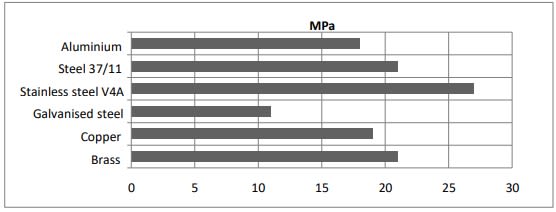
Average lap shear strengths, plastic-to-plastic joints, lightly abraded, alcohol degrease pretreatment (ISO 4587)
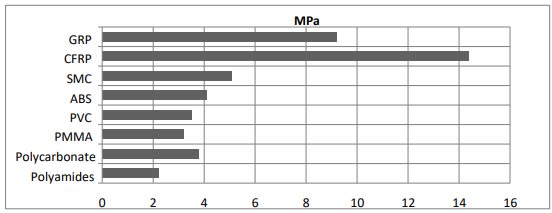
Average lap shear strength after immersion in various media (ISO 4587)
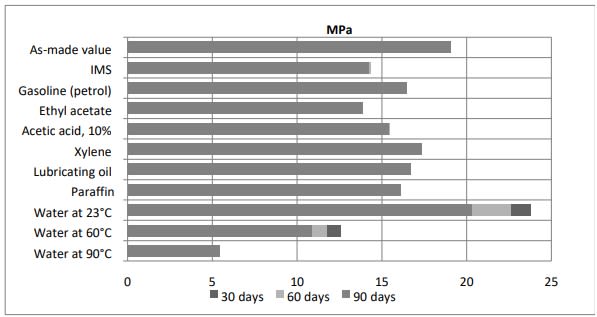
Lap shear strength versus tropical weathering** (ISO 4587)

Note: **40 / 92, DIN 50015; Typical average values; test at 23°C
Lap shear strength versus heat aging (ISO 4587) (typical average values)

Lap shear strength versus temperature (ISO 4587)

Note: ** On aluminum. Pretreatment - Sand blasting. Cure: (a) = 7 days at 23°C; (b) = 24 hours at 23°C + 30 minutes at 80°C
Roller peel test (ISO 4578) on etched aluminum
Cure Schedule Average Value Unit 48 hours at 20°C (68°F) 3.5 (20) N/mm (Pli) 16 hours at 40°C (104°F) 5.5 (31) N/mm (Pli) 2 hours at 80°C (176°F) 5.5 (31) N/mm (Pli) Additional Physical and Electrical Property Data
Property
Test Value
Unit
Test Method
Condition
Hardness 64 Shore D Flexural Strength 46 MPa ISO 178 Flexural Modulus 1650 MPa ISO 178 Dielectric Strength 425 Volt/mil ASTM D-149 Surface Resistivity 1.5 E+15 Ohm-cm IEC 60093 Volume Resistivity 5.7 E+14 Ohm-cm IEC 60093 Dielectric Constant 4.4 IEC 60250 at 50 Hz Dielectric Constant 4.4 IEC 60250 at 1 kHz Dielectric Constant 4.3 IEC 60250 at 10 kHz Loss Tangent 0.8 % IEC 60250 at 50 Hz Loss Tangent 0.7 % IEC 60250 at 1 kHz Loss Tangent 1.0 % IEC 60250 at 10 kHz - Application of Adhesive
- This system is available in cartridges incorporating mixers and can be applied as ready to use adhesive with the aid of the tool recommended by Huntsman Advanced Materials.
- The resin/hardener mix may be applied manually or robotically to the pretreated and dry joint surfaces.
- Huntsman's technical support group can assist the user in the selection of a suitable application method as well as suggest a variety of reputable companies that manufacture and service adhesive dispensing equipment.
- A layer of adhesive 0.05 to 0.10 mm (.002 to .004 in) thick will normally impart the greatest lap shear strength to the joint.
- Huntsman stresses that proper adhesive joint design is also critical for a durable bond. The joint components should be assembled and secured in a fixed position as soon as the adhesive has been applied.
- Pretreatment
Pretreatment
- The strength and durability of a bonded joint are dependent on proper pretreatment of the surfaces to be bonded.
- At the very least, joint surfaces should be cleaned with a good degreasing agent such as acetone or other proprietary degreasing agents in order to remove all traces of oil, grease and dirt.
- Low grade alcohol, gasoline (petrol) or paint thinners should never be used.
- The strongest and most durable joints are obtained by either mechanically abrading or chemically etching (“pickling”) the degreased surfaces.
- Abrading should be followed by a second degreasing treatment.
Properties
Regulatory & Compliance
- Certifications & Compliance
Technical Details & Test Data
- Typical Times to Minimum Shear Strength on Sandblasted Aluminum / Contact Pressure
Temperature (°C) 10 15 23 40 60 100 Cure time (min) to reach Lap Shear Strength > 1 MPa 35 20 20 5 2 <1 Cure time (min) to reach Lap Shear Strength > 10 MPa 120 70 60 25 10 2 - Equipment Maintenance
- All tools should be cleaned with hot water and soap before adhesives residues have had time to cure.
- The removal of cured residues is a difficult and time-consuming operation.
- If solvents such as acetone are used for cleaning, operatives should take the appropriate precautions and, in addition, avoid skin and eye contact.
- Typical Physical Properties
- Unless otherwise stated, the data were determined with typical production batches using standard test methods.
- They are typical values only, and do not constitute a product specification.
- Unless otherwise stated, the figures given below were all determined by testing standard specimens made by lap-jointing 114 x 25 x 1.6 mm (4.5 x 1 x .063 in) strips of aluminum alloy. The joint area was 12.5 x 25 mm (.5 x 1 in) in each case.
- Samples were cured at 40°C (104°F) for 16 hours and tested at 23°C (73°F), unless otherwise noted.
Average lap shear strengths, metal-to-metal joints, sand blasting pre-treatment (ISO 4587)
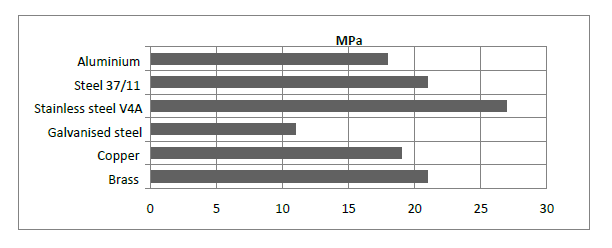
Average lap shear strengths, plastic-to-plastic joints, lightly abraded, alcohol degrease pre-treatment (ISO 4587)
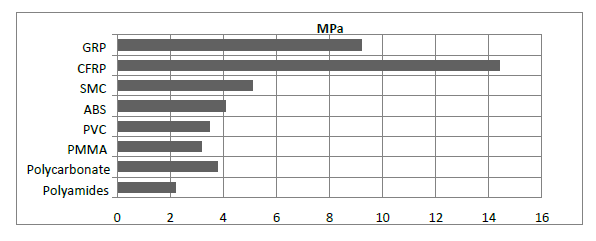
Average lap shear strength after immersion in various media (ISO 4587)
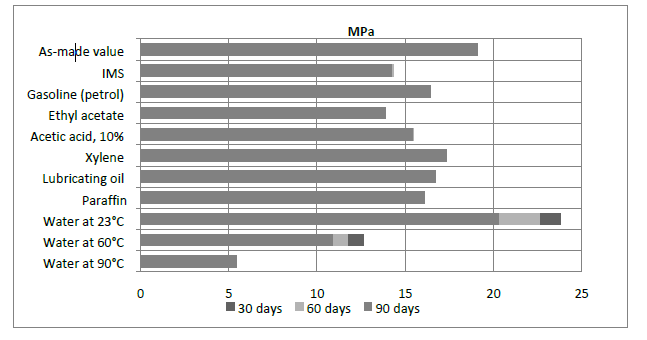
Lap shear strength versus tropical weathering** (ISO 4587)

**40 / 92, DIN 50015; Typical average values; test at 23°C
Lap shear strength versus heat aging (ISO 4587) (typical average values)

Lap shear strength versus temperature (ISO 4587)
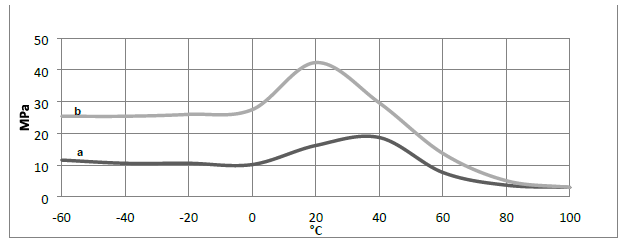
**On aluminum. Pretreatment - Sand blasting. Cure: (a) = 7 days at 23°C; (b) = 24 hours at 23°C + 30 minutes at 80°C
Roller peel test (ISO 4578) on etched aluminum
Cure Schedule Average Value (N/mm) 48 hours at 20°C 3.5 16 hours at 40°C 5.5 2 hours at 80°C 5.5
Safety & Health
- Safety Information
Keep out of reach of children
Packaging & Availability
- Regional Availability
Storage & Handling
- Storage and Shelf Life Information
- ARALDITE® 2012 A/B should be stored in a dry place, in the original sealed containers, at temperatures between 2°C and 40°C (36°F and 104°F).
- Under these storage conditions, the product has a shelf life of 3 years (from date of manufacture).
- The product should not be exposed to direct sunlight. If stored below 60°F, the adhesive should be brought to 60°F - 77°F and conditioned at this temperature for some time prior to use.
- Storage Conditions
ARALDITE® 2012 A/B should be stored in a dry place, in the original sealed containers, at temperatures between 2°C and 40°C (36°F and 104°F). Under these storage conditions, the product has a shelf life of 3 years (from date of manufacture). The product should not be exposed to direct sunlight.
If stored below 60°F, the adhesive should be brought to 60°F - 77°F and conditioned at this temperature for some time prior to use.
Other
- Application Information
Value Units Test Method / Conditions Fixture Time 20.0 m m at 23°C Mix Ratio 1.0 %(W) %(W) Hardener : Resin - Physical Properties
Value Units Test Method / Conditions Lap Shear Strength min. 20.0 MPa MPa Internal Method at 25°C Specific Gravity approx. 1.18 - Viscosity 25.0-65.0 Pa.s Pa.s ASTM A191 at 23°C
